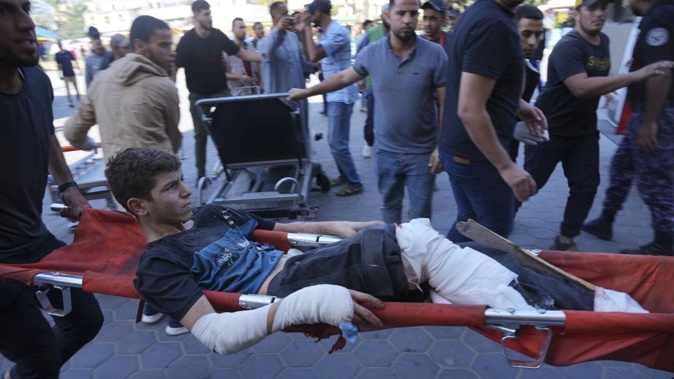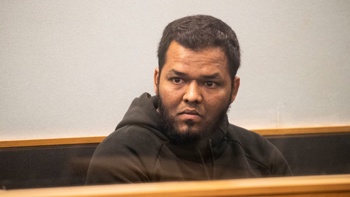
The doctors gave Shaimaa Nabahin an impossible choice: lose your left leg or risk death.
The 22-year-old had been hospitalised in Gaza for about a week, after her ankle was partially severed in an Israeli airstrike, when doctors told her she was suffering from blood poisoning. Nabahin chose to maximise her chances of survival, and agreed to have her leg amputated 15cm below the knee.
The decision upended life for the ambitious university student, as it has for untold others among the more-than-54,500 war wounded who faced similar gut-wrenching choices.
“My whole life has changed,” said Nabahin, speaking from her bed at the Al-Aqsa Martyrs Hospital in the central town of Deir al-Balah. “If I want to take a step or go anywhere, I need help.”
The World Health Organisation and the Health Ministry in Hamas-run Gaza say amputations have become commonplace during the Israel-Hamas war, now in its 12th week, but could not offer precise figures. At the hospital in Deir al-Balah, dozens of recent amputees are in various stages of treatment and recovery.
Experts believe in some cases, limbs could have been saved with proper treatment. But after weeks of Israel’s blistering air and ground offensive, only nine out of Gaza’s 36 hospitals are still operational. They are greatly overcrowded, offer limited treatment and lack basic equipment to perform surgeries. Many wounded are unable to reach the remaining hospitals, pinned down by Israeli bombardment and ground combat.
Sean Casey, a WHO official who visited several hospitals in Gaza, said the acute lack of vascular surgeons — the first responders to trauma injuries and best positioned to save limbs — was increasing the likelihood of amputations.
But also in many cases, he said, the severe nature of the injuries meant some limbs were not salvageable, and needed to be removed as soon as possible.
“People may die of the infections that they have because their limbs are infected,” Casey told a news conference last week. “We saw patients who were septic.”
Israel declared war after Hamas militants stormed across the border on October 7, killing some 1200 people, mostly civilians, and taking more than 240 hostages. Israel has vowed to keep up the fight until Hamas is destroyed and removed from power in Gaza and all the hostages are freed. More than 20,600 Palestinians have been killed in the fighting, about 70 per cent of them women and children, according to Gaza’s Health Ministry, which does not differentiate between civilians and combatants among the dead.
Before the war, Gaza’s health system was overwhelmed after years of conflict and a border blockade enforced by Israel and Egypt in response to the 2007 Hamas takeover of the territory. In 2018 and 2019, thousands were wounded by Israeli army fire in weekly Hamas-led anti-blockade protests, and more than 120 of the wounded had limbs amputated.
Even then, Gaza amputees had a hard time getting prostheses that would help them return to an active life.
Those joining the ranks of amputees now face near-impossible conditions. Some 85 per cent of the population of 2.3 million have been displaced, crowding into tents, schools-turned-shelters or homes of relatives. Water, food and other basic supplies are scarce.
On November 13, when an Israeli airstrike hit the home of Nabahin’s neighbour in Bureij, an urban refugee camp in central Gaza, her ankle and arteries in her leg were partially severed by a clump of cement that blew into her home from the explosion next door. She was the only one of her family who was injured, while several of her neighbours were killed, she said.
/cloudfront-ap-southeast-2.images.arcpublishing.com/nzme/Y3DRHJQYS5HNRPES5T72WAYULI.jpg) Palestinians in Burej fleeing to the southern Gaza Strip. Photo / AP
Palestinians in Burej fleeing to the southern Gaza Strip. Photo / AP
She was quickly taken to nearby Al-Aqsa Martyrs Hospital, where doctors managed to sew up her leg and and stop the bleeding.
But after that, Nabahin said she received minimal treatment or attention from doctors, who were dealing with a growing number of critically wounded people amid dwindled medical supplies. Days later, her leg turned a dark colour, she said.
“They discovered that there was … shrapnel that was poisoning my blood,” she said.
The amputation went well, but Nabahin said she remained in acute pain and couldn’t sleep without sedatives.
Jourdel Francois, an orthopaedic surgeon with Doctors Without Borders, says the risk of post-op infections in war-stricken Gaza is high. Francois, who worked at Nasser Hospital in the southern town of Khan Younis in November, said hygiene was poor, mainly because of scarce water and the general chaos in a hospital that’s overwhelmed with patients while hosting thousands of displaced civilians.
He recalled a young girl whose legs had been crushed and urgently needed a double amputation, but she couldn’t be booked into surgery that day because of the high number of other critical injuries. She died later that night, Francois said, probably from sepsis, or blood poisoning by bacteria.
Take your Radio, Podcasts and Music with you









